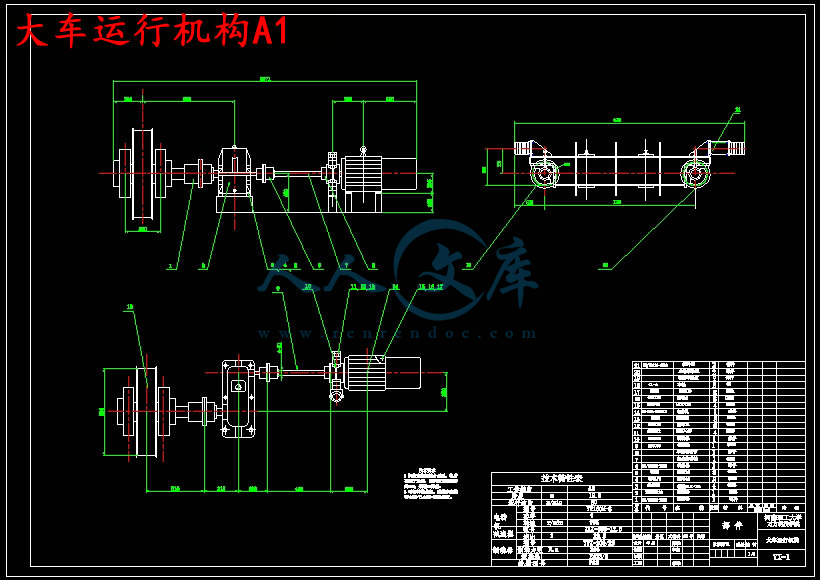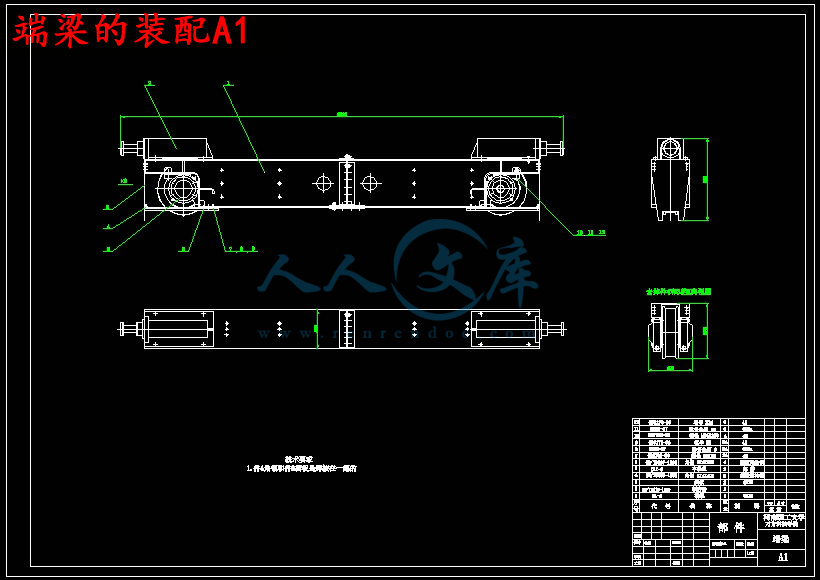【温馨提示】 购买原稿文件请充值后自助下载。
以下预览截图到的都有源文件,图纸是CAD,文档是WORD,下载后即可获得。
预览截图请勿抄袭,原稿文件完整清晰,无水印,可编辑。
有疑问可以咨询QQ:414951605或1304139763
摘 要
本次毕业设计是针对毕业实习中桥式起重机所做的具体到吨位级别的设计。我国现在应用的各大起重机还是仿造国外落后技术制造出来的,而且已经在工厂内应用了多年,有些甚至还是七八十年代的产品,无论在质量上还是在功能上都满足不了日益增长的工业需求。如何设计使其成本最低化,布置合理化,功能现代化是我们研究的课题。本次设计就是对小吨位的桥式起重机进行设计,主要设计内容是10t桥式起重机的结构及运行机构,其中包括桥架结构的布置计算及校核,主梁结构的计算及校核,端梁结构的计算及校核,主端梁连接以及大车运行机构零部件的选择及校核包括: 轮压计算及强度验算, 运行阻力计算,选择电动机,减速器的选择验算,运行速度及实际功率,选择制动器,选择联轴器,低速浮动轴的验算,缓冲器的选择等计算。还有小车的运行和起升机构零部件的选择及校核包括: 运行阻力计算,选电动机,选择减速器验算起动时间,按起动工况校核减速器功率,选择制动器,选择高速轴联轴器及制动轮,验算低速浮动轴强度,钢丝绳的选择,滑轮、卷筒的计算,联轴器的选择。
关键词: 起重机;大车运行机构;小车运行结构;小车起升结构;桥架 ;
主端梁
Abstract
The graduation design is aimed at the graduation fieldwork medium-sized crane do specific to tonnage level of design. Our country is the application of the big crane or counterfeit foreign backward technology out of manufacture and has within the plant for many years, some even application or the 70s and 80s products, both in quality and in on the function can't satisfy the growing industrial demand. How to design makes it the lowest cost, decorate rationalization, functional modernization is our topic. This design is on small tonnage design of bridge crane, the main design content is 10t bridge crane structure and operation organization, including bridge structure arrangement calculation and checking the structure of the girder, the calculation and checking, calculated and checked the beam structure, the main girders connection and cart mechanism parts selection and checking including: wheel pressure calculation and intensity checking, running friction calculation, the choice of motor, gear reducer is checked, choose speed and actual power, choose brakes, choose coupling calculating speed floating axis, buffer choice calculation, etc. And car running and lifting mechanism parts selection and checking including: running friction calculation, choose motor, choose reducer, by starting checked start-up time check reducer power, choose working brakes, choose high-speed couplings and brake wheel, the checking low-speed axial intensity, the wire rope floating choice, pulley, drum calculation, coupling choice.
Keywords: cranes; During operation organization; Car running structure; Car hoisting structure; Bridge; Main girders
目录
摘 要 1
Abstract 2
前 言 1
第1章 桥式起重机的概述 2
1.1 桥式起重机的特点 2
1.2 桥式起重机的用途 5
1.3 桥式起重机的基本参数 5
1.4 桥式起重机主要零部件 9
1.4.1吊钩 9
1.4.2钢丝绳 11
1.4.3 滑轮和滑轮组 13
1.4.4 滑轮组类型及选配原则 14
1.5滑轮组及其滑轮组的倍率 15
1.6 卷筒 16
1.7 位置限位器 17
1.8 缓冲器 18
1.9桥式起重机发展概述 18
1.9.1 国内桥式起重机发展动向 18
1.9.2 国外桥式起重机的发展动向 19
第2章 大车运行机构的设计 21
2.1大车运行结构设计的基本思路及要求 21
2.2 大车运行机构传动方案的确定 21
2.3 大车运行机构具体布置时要注意的问题 22
2.4 大车运行机构的设计计算 23
2.4.1 大车运行结构的传动方案 23
2.5轮压计算及强度验算 24
2.5.1计算大车的最大轮压和最小轮压 24
2.5.2 强度计算及校核 25
2.6 运行阻力计算 27
2.7 选择电动机 28
2.8 减速器的选择 30
2.9 验算运行速度及实际功率 30
2.10 验算启动时间 31
2.11 起动工况下校核减速器功率 33
2.12 验算起动不打滑条件 33
2.13 选择制动器 36
2.14 选择联轴器 37
2.15 低速浮动轴的验算 38
2.16 缓冲器的选择 40
第3章 起升小车的计算 43
3.1 确定机构的传动方案 43
3.2小车运行机构的计算 44
3.3选择车轮与轨道并验算起强度 44
3.4运行阻力计算 46
3.5 选电动机 48
3.6 验算电动机发热条件 49
3.7 选择减速器 49
3.8 验算运行速度和实际所需功率 49
3.9验算起动时间 50
3.10 按起动工况校核减速器功率 51
3.11 验算起动不打滑条件 52
3.12 选择制动器 53
3.13 选择高速轴联轴器及制动轮 54
3.14 验算低速浮动轴强度 56
3.15 起升机构的设计参数 57
3.16 钢丝绳的选择 58
3.17 滑轮、卷筒的计算 59
3.18 根据静功率初选电动机 61
3.19 减速器的选择 61
3.20 制动器的选择 63
3.21 启动时间及启动平均加速度的验算 63
3.22 联轴器的选择 65
第4章 桥架结构的设计 66
4.1 桥架的结构形式 66
4.1.1 箱形双梁桥架的构成 66
4.1.2 箱形双梁桥架的选材 66
4.2 桥架结构的设计计算 67
4.2.1 主要尺寸的确定 67
4.2.2 主梁的计算 69
4.3 端梁的计算 76
4.4 端梁的尺寸的确定 82
4.4.1 端梁总体的尺寸 82
4.4.2端梁的截面尺寸 82
第5章 端梁接头的设计 83
5.1 端梁接头的确定及计算 83
5.1.1 腹板和下盖板螺栓受力计算 84
5.1.2 上盖板和腹板角钢的连接焊缝受力计算 85
5.2 计算螺栓和焊缝的强度 86
5.2.1 螺栓的强度校核 86
5.2.2 焊缝的强度校核 87
总 结 91
致 谢 93
参考文献 94
前 言
桥式起重机是横架于车间和 料场上空进行物料调运的起重设备。由于它两端坐落在高大的水泥柱或金属架上,形状似桥,所以俗称“天车”。桥式起重机是现代工业和起重运输中实现生产过程机械化、自动化的重要工具与设备,可减轻操作者的劳动强度,可大大提高生产率。桥式起重机在工矿企业、钢铁化工、铁 路交通、港口码头以及物流周转等部门和场所应用的最为广泛,是人们生产生活不可或缺的一种设备。
随着工业的迅速发展和科学技术的不断进步,桥式起重机在结构设计及自动化程度上相继出现了一些新的变化和新的特点,在结构上,国内起重设备已采用计算机优化设计,以提高起重机的机械性能,在起重质量方面逐步向大型化发展,大型桥式起重机正在钢铁、水利、发电等行业不断出现,令人世人瞩目的三峡发电厂安装了两台1200T/125T的桥式起重机,2007年9月,起重量达2万吨的桥式起重机在山东烟台佛士船厂投入使用,它标志这我国起重机行业以达到世界先进水平。
总之,随着科技的迅速发展,国内各种先进的电气控制和机械技术正逐步应用到起重机上,起重机的自动化程度越来越高,结构日趋简单,性能愈加可靠,起重量越来越大,品种也越来越全。
对于起重量大、跨距大的起重设备多采用箱型双梁式,箱型双梁桥式起重机有一个由两根箱型主梁和两根横向端梁构成的双梁桥架,在桥架上运行小车,可起吊和水平搬运各类物件。它适用于机械加工和装配车间、仓库和料场等场所。 箱型双梁结构具有加工零件少、工艺性好、通用性好及安装检修方便等优点,因而在生产中广泛使用。
第1章 桥式起重机的概述
桥式起重机是桥架型起重机的一种,主要依靠起升机构和在水平面内的两个相互垂直方向移动的运行机构,能在矩形场地及其上空作业,是工矿企业广泛使用的一种其中运输机械。它具有承载能力大、工作可靠性高、制造工艺相对简单的优点。
桥式起重机一般有大车运行机构的桥架、起升机构和小车运行机构的起重小车、电气设备、司机室等机构组成,外形像一个两端支撑在平行的两条架空轨道上平移运行的单跨平板桥。起升机构用来垂直升降物品,起重小车用来带着载荷作横向移动,以达到在跨度内和规定高度内组成三维空间里做搬运和装卸货物用。
桥式起重机是使用最广泛、拥有量最大的一种轨道运行式起重机,其额定起重量从及吨到几百吨。最基本的形式是通用吊钩桥式起重机,其他形式的桥式起重机都是在通用吊钩桥式起重机的基础上派生发展出来的。
1.1 桥式起重机的特点
桥式起重机是横架于车间、仓库和料场上空进行物料吊运的起重设备。由于它两端坐落在高大的水泥柱上或金属支架上,形状似桥,所以俗称“天车”和“行车”。它是使用、范围最广、数量最多的一种起重机械。
桥式起重机是现代工业生产和起重运输中实现生产过程机械化、自动化的重要工具和设备,可减轻操作者的劳动强度,提高生常率。桥式起重机在工矿企业、钢铁化工、铁路交通、港口码头以及物流周转等部门








 川公网安备: 51019002004831号
川公网安备: 51019002004831号